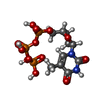+Search query
-Structure paper
| Title | Structure of eukaryotic DNA polymerase δ bound to the PCNA clamp while encircling DNA. |
|---|---|
| Journal, issue, pages | Proc Natl Acad Sci U S A, Vol. 117, Issue 48, Page 30344-30353, Year 2020 |
| Publish date | Dec 1, 2020 |
 Authors Authors | Fengwei Zheng / Roxana E Georgescu / Huilin Li / Michael E O'Donnell /  |
| PubMed Abstract | The DNA polymerase (Pol) δ of (S.c.) is composed of the catalytic subunit Pol3 along with two regulatory subunits, Pol31 and Pol32. Pol δ binds to proliferating cell nuclear antigen (PCNA) and ...The DNA polymerase (Pol) δ of (S.c.) is composed of the catalytic subunit Pol3 along with two regulatory subunits, Pol31 and Pol32. Pol δ binds to proliferating cell nuclear antigen (PCNA) and functions in genome replication, repair, and recombination. Unique among DNA polymerases, the Pol3 catalytic subunit contains a 4Fe-4S cluster that may sense the cellular redox state. Here we report the 3.2-Å cryo-EM structure of S.c. Pol δ in complex with primed DNA, an incoming ddTTP, and the PCNA clamp. Unexpectedly, Pol δ binds only one subunit of the PCNA trimer. This singular yet extensive interaction holds DNA such that the 2-nm-wide DNA threads through the center of the 3-nm interior channel of the clamp without directly contacting the protein. Thus, a water-mediated clamp and DNA interface enables the PCNA clamp to "waterskate" along the duplex with minimum drag. Pol31 and Pol32 are positioned off to the side of the catalytic Pol3-PCNA-DNA axis. We show here that Pol31-Pol32 binds single-stranded DNA that we propose underlies polymerase recycling during lagging strand synthesis, in analogy to replicase. Interestingly, the 4Fe-4S cluster in the C-terminal CysB domain of Pol3 forms the central interface to Pol31-Pol32, and this strategic location may explain the regulation of the oxidation state on Pol δ activity, possibly useful during cellular oxidative stress. Importantly, human cancer and other disease mutations map to nearly every domain of Pol3, suggesting that all aspects of Pol δ replication are important to human health and disease. |
 External links External links |  Proc Natl Acad Sci U S A / Proc Natl Acad Sci U S A /  PubMed:33203675 / PubMed:33203675 /  PubMed Central PubMed Central |
| Methods | EM (single particle) |
| Resolution | 3.2 Å |
| Structure data | EMDB-22803: Cryo-EM 3D map of the Saccharomyces cerevisiae replicative polymerase delta in complex with a primer/template and the PCNA clamp |
| Chemicals |  ChemComp-MG:  ChemComp-SF4:  ChemComp-D3T:  ChemComp-ZN: |
| Source |
|
 Keywords Keywords |  REPLICATION / Polymerase delta / REPLICATION / Polymerase delta /  PCNA / primed DNA / PCNA / primed DNA /  complex complex |
 Movie
Movie Controller
Controller Structure viewers
Structure viewers About Yorodumi Papers
About Yorodumi Papers






